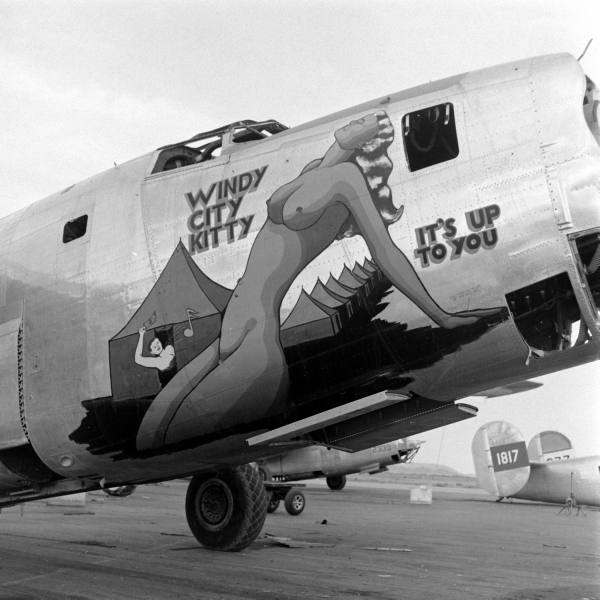
Photo depicts a B-24 in the boneyard at Kingman, Arizona, in its final hours of existence. Huge numbers of surplus aircraft arrived for the final chopping and recycling of the much-needed aluminum. This site had a vast desert full of surplus bombers of all types, that were stripped from engines, oils, and electronics. Finally, the cutting torch or cutter showed up in order to scrap the ripped airframe back to smaller pieces that could be dumped into the smelting ovens.
During WWII, an unparalleled number of aircraft had been built for the US Military in a time span of 4-5 years only. Allegedly,over 100.000 planes of all types were constructed in a large number of plants, scattered all over Continental USA. Not only the classic Aircraft Manufacturers as Curtiss, Douglas, Lockheed, Boeing, Noth American, Consolidated Vultee (later Convair), Martin etc. were involved in this historical largest ever mass production of aircraft, but also the Automotive Industry soon was engaged in this National War Effort. Ford was assembling the B-24 Liberator Bomber, and GM and Studebaker all had their role in the assembly of aircraft and the engines needed for such gigantic fleet.
With nearly 19.000 units (8.000 produced by Ford) it holds the record of being the most produced American Military Aircraft. But by the end of the war, this Consolidated B-24 Liberator had been surpassed in technology by more modern types such as the Boeing B-29 Superfortress. Imagine, the huge numbers of surplus aircraft that had to be recycled right after WWII and went straight back to the scrap yards.
A fleet consisting of Flying Legends that won the War for America and its Allies, but went down the drain in a matter of years. Those Bombers were obsolete due to their lack of payload, range, speed and with their non-compressed fuselages unable to cope with the latest strategic demands in a newly emerging Cold War Theater. The aircraft production between 1940-1945 was the highest ever in such short time span, the rate of deliberate surplus aircraft destruction between 1945-1950 went parallel with that record.
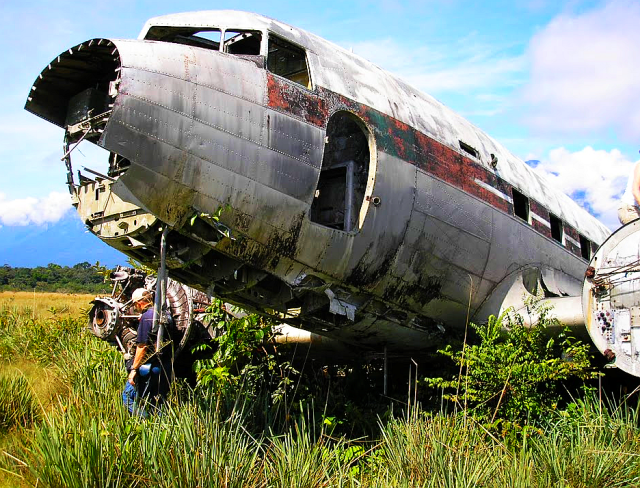
Photo above depicts a C-47/ DC-3 that went down near Canaima, Venezuela, close to the Table Mountain from where the `Angel Falls` come down. This aircraft was visited by me in the year 2000 . It had made an emergency landing in this flat Sabana after one engine quit. With that, the crew was unable to maintain their altitude while they probably tried to make a landing on the nearby Canaima airstrip. Allegedly, the aircraft was overloaded with mining equipment. Others say it was more probably a Drugs Transport, but both options were illegal cargo, always prone for overcharging the aircraft. Later , the Left-Hand engine and all instruments, props etc were dismantled and taken out by helicopter. Those were valuable parts for the Rutaca and Servivensa fleets of 10 to 12 DC-3´s that were shuttling tourists from the Isla de Margarita to the Angel Falls/ Canaima National Park, in Southern Venezuela.
It was the Cargo Plane of WWII fame that survived the Post War Aluminium Melt Down frenzy that killed the Bombers in such huge numbers. The World craved for air transport and all that was available from the US Military Surplus shelves had a worldwide value by far exceeding its scrap value. That simple fact initiated the first post-war survival of the C-46 Curtiss Commando, the Douglas C-47/ DC-3/ Dakota, the C-54, DC-4 Skymaster and a few other types with lower numbers. From scratch, their designs had been aircraft made for Passenger (or Paratrooper) Transport, making the conversion back from Military version to Civil Version relatively easy. The bomber designs, on the other hand, were often handicapped with mid wing configurations that crossed the fuselage, making the passenger transport awkward, uncomfortable and far from cost efficient due to the relatively low number of seats/ pax.
The Douglas C-47 / DC-3 production made its production run between 1936 and 1946 in 4 plants. Total US production score of the type stopped at just over 10.600 units, with that the most produced Cargo Plane in the World. (Russia and Japan made both a license built production of the DC-3/ C-47, which in total will likely have added another 5000 aircraft to the Global score of Douglas “Gooney Bird” design, be it with slightly different designs of airframe details and engines). With this record production number, it is clear that this aircraft-type DC-3/ Dakota/ C-47 came out as the overall longevity winner of wartime produced aircraft. Both in survival rate, in the global spread, and evidently, in the current numbers of still operational or static/ crashed/ abandoned aircraft.
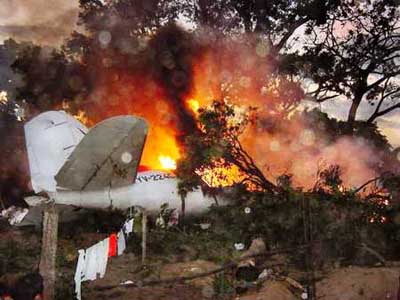
Photo above depicts the crash of the DC-3 YV-224C operated by Rutaca, from Ciudad Bolivar, Venezuela. Rutaca had a very sound reputation with its fleet of old Dakotas that served the Tourist Flight Market from Isla Margarita to Canaima National Park. I hired this aircraft for a week as a Motorhome and Photo model for a Clothing Brand campaign, that still runs that theme successfully until today. Two months later, this aircraft had a fatal crash that cost all 24 passengers their lives, including tourists from USA, Holland and Italy. In order to safeguard the overseas tourist influx, the Aviation Authority of Venezuela had no other choice than to stall all Dakota operations in Venezuela overnight. Ten DC-3’s were grounded, never to fly again over Venezuela, but that could not stop the fall of International Tourism to Venezuela. That is a very sad development, as the Canaima National Park and its Angel Falls are an exceptionally scenic jungle site, as I have rarely seen, and so comfortably from the seat of a low and slow flying DC-3 that orbited the Table Mountain. A magic place, as a real life Jungle Book. I surely would love to go back there one day again.
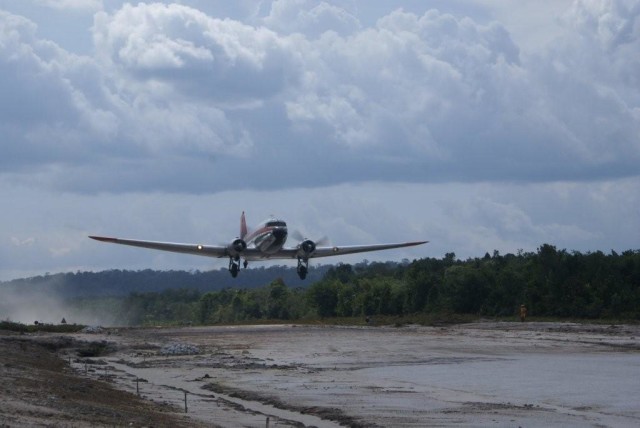
Photo above (courtesy Julie le Bolzer, published in my book The Dakota Hunter) reflects a good reasoning for the second stage “Survival of the Gooney Bird”. Right after WWII, there was an urgent need for passenger transport worldwide, the DC-3 filled the surge with instant availability in great numbers. But soon bigger, faster and longer range became the requirement for Transcontinental Passenger Transport. It relegated the role of the Dakota back to more primitive conditions and sites where only basic facilities are available. The DC-3 was designed in an era that many airfields still had grass or gravel strips: only “Big Wheels” are the outfit that can handle such strips, with a low approach speed and tail dragger configuration being a much better match coping with the moguls/ bumps hidden in the field.
While the Western World constructed bigger and better airfields with asphalted airstrips, there remains a remote world in the vast Jungle of the Amazon, where asphalt has not yet arrived. It is a “Last Frontier’s World” where aircraft can only land on a muddy jungle strip or on a narrow gravel river bank (see photo). This is the final realm of the DC-3, where any other (Turbo) Prop or Jet aircraft with its small diameter tricycle landing gear and high approach speed would have an instant problem to land. After so many accidents with modern aircraft, there remains only one winner in this domain, the 70+ years old WW II/ Korea/ Vietnam Veteran C-47 , that flies in 3 tons of Cargo with 2 x 1200 max hp radial piston low-tech engines, made until the 1960’s.
It is here and a few other places in this world (Alaska, Canada, Caribbean, Opa Locka, Honduras etc.) from where this legendary Dc-3 is still doing operational flights on a commercial (or Military) base, i.e. making revenues for the owner. You need a lot of fantasy to imagine a transport in the world that at 70 years of age can still do that! If you have a clue for a Car, a Truck, a Boat , a Train , a Blimp or Aircraft that can boast such Transport career and still survive in 250 + numbers, you let me know, please!
The Jurassic Park of Aviation still exists, that is a most remarkable feat. But there is a dark side on every historical life extension of a mechanical machine or transport. Those aircraft were designed and built to last for 20-30 years at best. How will that match with 70 years of daily operations? In the 25 years that I hunt Dakota’s all over the Globe, I have seen the dark side of this endurance show its nasty face with fatalities and strange incidents that almost always ended up with more stringent rulings, less cargo/passengers allowed and in worst cases, the total grounding of the Dakota flight (see the Venezuelan accident with YV-224C. All details of that sad accident and others are written in my book).
In contrast, I have spent quite some time and made many flights in Colombia with the DC-Tres. The incident rate was exceptionally low until recently, especially when considering the very harsh and primitive conditions in which the Dakota flies and operates when flying the remote Amazon Jungle airfields. Only this week, on 7 April 2016, there was a crash reported of a DC-3, fortunately with no fatalities! (Read the accident report below, under the photo). There was another accident a year ago, but that was due to pilot error, in bad weather & poor visibility, whereby the aircraft hit a hillside. That had nothing to do with mechanical failures of the aircraft or its engines.
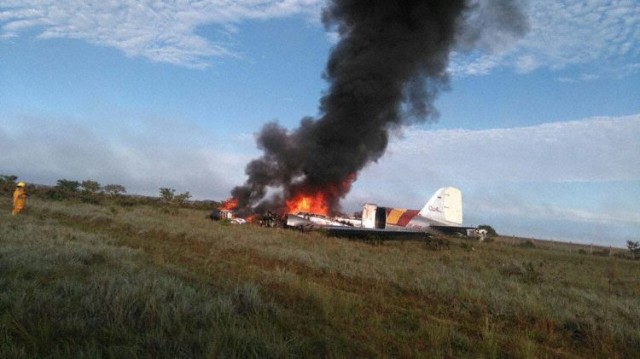
Photo shows the DC-3 accident: Arall DC3 at Puerto Gaitan, this week on April 7th, 2016, lost height after engine failure. AnArall Aerolineas Llaneras Douglas DC-3, registration HK-2663 performing a flight from Puerto Gaitan to Villavicencio (Colombia) with 3 crew, was climbing out of Puerto Gaitan when the left-hand engine (R-1830) failed. The aircraft lost height, the crew attempted an emergency landing outside the aerodrome. The aircraft burst into flames and was evacuated. Two crew received injuries and were taken to hospitals. Colombia’s Aeronautica Civil reported the DC-3, registration HK-2663, plunged to ground a few minutes after takeoff at 06:25L (11:25Z), two crew members were injured and were taken to hospitals. Other than Colombian media reported (claiming the aircraft was carrying 14 passengers) the aircraft did not carry passengers. Investigators have been dispatched to the accident site.
HK-2663 ablaze (Photo: William Alvarez): Courtesy www.avherald.com
I have often wondered how long this odd safety record of the Colombian DC-3 scene could ever last. According to many local experts, the pilots, the operators, and the local workshop management, responsible for the overhaul of the radial engines, the aircraft could survive for at least another decade! Remarkably, no one foresees any substitute yet for the DC-3. They simply don’t make or design any aircraft type anymore like this one, a taildragger with big balloon tires that can carry 3 tons of payload. The critical “soft spot” seems to be not so much in the airframe but in the engines, the radial Pratt & Whitney R-1830’s. All its spare parts are allegedly made half a century ago: is there a certain “Fatigue of Time” existing that makes metal spares having a date of expiration, no longer fit for safe “consumption”? Nonsense, the engine overhaul can be done over and over again, that is what others say, as long as there are spare parts on the shelf.
I foresee another long career for the C-47 airframe in this weird world of the Green Hell. But the first BT-67 (Basler Turbo Prop Conversion of the DC-3) has been introduced in the Villavicencio DC-Tres scene, and quite sure, more will follow as they have the future for another 20-25 years out there in Amazonia. The Jurassic Park of Aviation will be kept open for the public, may I invite you to come with me for a closer look? My book The Dakota Hunter gives you a detailed insight of what I encountered and experienced in the World of Vintage Aviation during my 20 + expeditions overt the Globe, in search of the Legendary DC-3 on the last Frontiers.
Engagingly written and illustrated with 250 unique photos, the book can be ordered at Amazon, directly via their order site with 5- star reviews. Or if you prefer, via my website, you can order the signed version of my book and you can read my previous Blogs, Reviews, and a sneak preview of my book at dc3dakotahunter.com


Δεν υπάρχουν σχόλια:
Δημοσίευση σχολίου